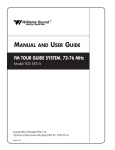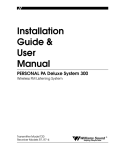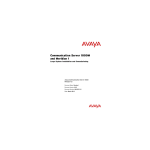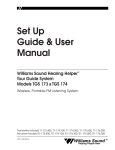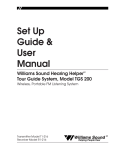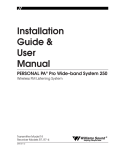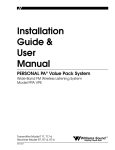Download Williams Sound TGS SYS A User manual
Transcript
Williams Sound Corp. Tour Guide System User Manual For Models: Systems: Transmitters: Receivers: TGS SYS A T16 R7, R7-4 Williams Sound TOUR GUIDE System Contents: Introduction 2 The Transmitter 2 Microphones 3 The Receiver 3 Headphones and Earphones 4 Operating Instructions 5 Hints for Using the System 6 Multiple System Operation 6 Battery Information 6 Re-Tuning the System 8 In Case of Difficulty 11 Warranty 12 Specifications 13 Williams Sound Corp. Page 1 Introduction: The FM Tour Guide System is a portable, high-performance, wireless system composed of the PPA T16 Transmitter and PPA R7 Receivers and designed for use in hearing assistance applications. The system allows one-way transmission of a tour guide’s voice to hearing impaired group members by using an FM radio signal. Using the system helps to overcome background noise and distance from the person speaking. The Tour Guide System can be used for large or small tour groups, in noisy or quiet environments. Under FCC regulations, the Williams Sound FM Tour Guide System may only be used for hearing assistance. FM radio signal Tour Guide uses Transmitter and Microphone Listeners use a Receiver and Headphones The T16 Transmitter: The T16 Transmitter is a battery-powered belt pack that is used with a microphone to pick up the tour guide's voice. The Transmitter produces an FM radio signal to broadcast the tour guide's voice to the receiver units. A simple slide switch on top of the transmitter turns the unit on or off. The T16 operates on a 9 Volt alkaline disposable battery or a 9V NiMH rechargeable battery. Tour Guide Transmitter MIC 044 Headset Microphone (dual plug model shown) Page 2 MIC 036 Hearing Protector MIC 081, MIC 054 Lapel Clip MIC 026 Hand-Held Microphones: A noise-cancelling, headset microphone (MIC 044) is the standard microphone. The noise-cancelling microphone helps to reduce background sounds in noisy environments. The microphone plugs into the "MIC" jack on top of the Transmitter. The microphone is positioned directly in front of the tour guide's mouth for maximum signal to noise ratio and so head movement does not affect the loudness of the signal. The microphone cord acts as the transmitting antenna. Optional Microphones: An optional Hearing Protector Headset Microphone (MIC 036) is also available for extremely high noise environments. It features ear muffs that completely cover both ears and provides 24 dB NRR of attenuation for hearing protection. An optional Lapel Clip Microphone can be used in quieter environments like museums or galleries. The MIC 081 has an omnidirectional pick-up pattern. The MIC 054 has a directional (or cardioid) pick-up pattern, which will reduce background noise somewhat. A small hand-held microphone (MIC 026) is also available for tour guides who prefer to hold the microphone. The R7 Receiver: The R7 Receiver is a battery-powered belt pack that is used with a headphone to hear the signal produced by the Transmitter. The Receiver is pre-tuned to the Transmitter and has a user-adjustable volume control. The headphone plugs into the "EAR/CHG" jack on top of the Receiver. The receiver is turned on by rotating the volume control wheel. The receiver operates on a 9 Volt alkaline disposable battery or a 9V NiMH rechargeable battery. Receiver and HED 021 Headphone Page 3 HED 008 Hearing Protector EAR 022 Surround Style EAR 014, EAR 013 Mini Earphone Headphones and Earphones: The HED 001 Lightweight Headphone is the standard headset for the Tour Guide System. It offers excellent sound quality and wearing comfort. The foam earpads may be removed for cleaning or replacement. Replacement pads are part number HED 003-10. The headphone plugs into the "EAR/CHG" jack on top of the Receiver. The headphones are wired with a mono plug. If a stereo headphone is substituted, it will only work on one side of the headphone. Optional Headphones and Earphones: The HED 008 is a heavy-duty, hearing-protector headset. The HED 008 earmuffs completely cover the ears and provide 24 dB NRR noise attenuation for hearing protection in high noise environments. The EAR 022 Surround Earphone offers excellent sound quality in a unique style that hangs on the ear. It is easy to keep clean since the earphone does not enter the ear. It is not recommended for high noise environments. The EAR 013 and EAR 014 are single and dual Mini Earphones. The earbud-style features a foam covering that fits in the outer ear. The foam pads can be removed for cleaning or replacement. Replacement pads are part number EAR 015-10. Earpad Care: Foam earpads may be removed and washed in a mild detergent, rinsed thoroughly, and air dried. Replacement pads are also available from Williams Sound. Page 4 Operating Instructions: (Step 1) Install the battery in the Transmitter. A 9V alkaline battery is included with the transmitter. If you are using a 9 Volt rechargeable battery, see page 6. Open the battery door on the Transmitter by lifting the battery door up. A coin may be used to help open the battery door. Carefully insert the battery, observing proper polarity. The large battery terminal (-) is nearest the top of the compartment. DO NOT FORCE THE BATTERY IN BACKWARDS. DAMAGE TO THE TRANSMITTER WILL RESULT! Close the battery door by snapping it shut. If you are using a disposable battery, use only 9V alkaline batteries (Eveready 522 or equiv.). A disposable battery should last 15 hours. A BAT 003 re-chargeable battery will last about 3 hours per charge. Large terminal (-) Battery Installation (Step 2) Plug the microphone into the "MIC/CHG" jack on top of the Transmitter. The Headset Microphone boom should be positioned as close to the wearer's mouth as possible without actually touching. Lapel Clip microphones should be attached to a collar or lapel, as close to the wearer's mouth as possible. (Step 3) The Transmitter can be placed in a pants pocket or clipped onto a belt or waistband in the Belt Clip Case included with the Transmitter. NOTE: The microphone cord is the transmitting antenna. Do not bunch it up or wrap it around the transmitter. Allow it to hang as straight as possible. (Step 4) Turn the Transmitter on by moving the slide switch on top of the Transmitter to "ON." To conserve battery life, there is no indicator light. Make sure you turn the Transmitter off when it is not in use to conserve the battery. Receiver Operation: (Step 1) Install the battery in the Receiver. A 9V carbon battery is included with each receiver. If you are using a rechargeable battery, see page 6. Open the battery door on the Receiver by lifting the battery door up. A coin may be used to help open the battery door. Carefully insert the battery, observing proper polarity. The large battery terminal (-) is nearest the top of the compartment. DO NOT FORCE THE BATTERY IN BACKWARDS. DAMAGE TO THE RECEIVER WILL RESULT! Close the battery door by snapping it shut. If you are using a disposable battery, you can use 9V carbon or alkaline batteries. A disposable carbon battery (Eveready 216 or equiv.) should last 15 hours. A disposable alkaline battery (Eveready 522 or equiv.) should last about 32 hours. A BAT 003 rechargeable battery will last about 6 hours per charge. (Step 2) Plug the headphones or earphone into the "EAR/CHG" jack on top of the Receiver. (Step 3) Turn the Receiver on by rotating the volume control wheel. Adjust the volume to a comfortable level. Page 5 Hints for Using the System: Normal operating distance between the Transmitter and Receiver is about 100 feet (30m). The operating range will vary in different buildings and surroundings. In some locations, the signal may momentarily disappear. This is called a "drop-out" and is due to reflection and cancellation of the radio signal. Moving a few feet will restore the signal. Keep the Transmitter and Receiver units at least two feet apart. If the Transmitter gets too close to a receiver, it can overload the Receiver, causing noisy reception or blocking of the signal. Do not coil or bunch up the microphone or headphone cords. The cords act as antennas. Let them hang at full length for the best results. Do not use more than one Transmitter on the same channel (frequency) at the same time unless they are physically separated by 50 to 100 feet (15 - 30 m). Operating more than one Transmitter on the same channel at the same time in the same place will result in interference. Using Multiple Systems for Multiple Groups: For multiple tour groups within the same facility, multiple Tour Guide Systems may be operated on the same channel at the same time by maintaining physical separation of 50 - 100 feet between groups. The physical separation of groups takes advantage of the FM capture effect which causes receivers to lock onto the closest transmitter. Up to four systems can be operated simultaneously in the same facility if they all operate on different channels. Channels A,C,E, and G may be used simultaneously. Additional Battery Information: Recommended Batteries: For Transmitters: Eveready 522 Alkaline 9V or equivalent BAT 003 rechargeable NiMH only BAT 004, BAT 005, or CHG 1269A Chargers only for BAT 003 For Receivers: Eveready 216 Carbon 9V, Eveready 522 Alkaline 9V or equiv. BAT 003 rechargeable NiMH only BAT 004, BAT 005, or CHG 1269 Chargers only for BAT 003 Battery Life: For Transmitters: For Receivers: 15 hours for Eveready 522 Alkaline 9V or equivalent 3 hours per charge for BAT 003 rechargeable 15 hours for Eveready 216 Carbon 9V or equivalent 32 hours for Eveready 522 Alkaline 9V or equivalent 6 hours per charge for BAT 003 rechargeable If the sound becomes weak or distorted, replace the battery. The indicator light may still be on, even with a battery that is weak. Do not leave dead batteries in the receivers. Rechargeable Batteries: (1) Rechargeable batteries are shipped in a discharged condition. They must be charged for 12 - 14 hours before using them. Make sure Transmitters and Receivers are turned OFF while charging. (2) Williams Sound products are designed for use with a rechargeable battery (BAT 003) and matching charger (BAT 004, BAT 005, or CHG 1269). This is the only type of rechargeable battery and charger we recommend. The BAT 003 has an 8.4 V nominal voltage and 100mAh capacity, compared to only 7.2V and 60 mAh for other types of Page 6 Batteries and Chargers rechargeable "9V" batteries. The BAT 003 provides significantly longer battery life per charge than lower voltage batteries. Chargers: The BAT 005 Single Charger has a cord that plugs into the receiver "EAR/CHG" jack to charge the battery. The BAT 004 Charger has snaps for direct attachment of a 9V rechargeable battery. The CHG 1269 Multiple Charger can charge 12 receivers simultaneously through the receiver "EAR" jacks. See the instructions included with the CHG 1269 for more information. The battery does not have to be removed from the receiver or transmitter for charging with the BAT 005 and CHG 1269 Chargers. Do not mix and match batteries and chargers from different manufacturers. Using the BAT 003 battery with chargers designed for lower-voltage batteries can result in under-charging and unsatisfactory battery life. Using the BAT 004, BAT 005, or CHG 1269 Charger with low-voltage batteries can result in over-charging and battery failure. NOTE: Do not dispose of batteries in fire. Do not open batteries - toxic chemicals inside. DO NOT attempt to recharge disposable batteries! Battery Charging Instructions: (Step 1) Make sure the Transmitter or Receiver is turned OFF while it is charging. (Step 2) To charge the battery without removing it from the Transmitter or Receiver, use the BAT 005 Charger or the CHG 1269 Multiple Charger. Plug the Charger cord into the earphone jack (labeled EAR/CHG) on a Receiver. Plug the cord into the microphone jack (MIC) on Transmitters. Then plug the Charger into an AC wall outlet. The Charger indicator light will glow while the battery is charging. Charge for 12-14 hours. DO NOT CHARGE THE BATTERIES LONGER THAN 14 HOURS. (Step 3) To charge the battery outside the unit or to keep a spare battery charged, use the BAT 004 Charger. Remove the battery from its compartment and attach it to the snaps on the Charger. Then plug the Charger into an AC wall outlet and charge for 12-14 hours. The battery should be from the DO NOT CHARGE THE BATTERIES LONGER THAN 14 HOURS. (Step 4) Expected Battery Life: 6 hours per charge for a Receiver. 3 hours per charge for a Transmitter. With normal service, the BAT 003 rechargeable battery should last approximately 1 year before it will need to be replaced. Page 7 Instructions for the R7-4 Multi-Channel Receivers: The multi-channel Receivers have a rotary selector knob on top which allows the user to select any of four operating channels. The R7-4 tunes channels ACEG. These receivers are designed for use in multiple channel systems with a number of tour groups or language groups. Re-Tuning the TOUR GUIDE System: Radio Interference: The TOUR GUIDE System is usually not disturbed by other radio services, however there is no such thing as a clear or exclusive channel for ANY radio service. One of the unique features of the Williams Sound TOUR GUIDE System is that the operating frequency can easily be changed in the field to avoid interference. There are ten possible frequencies for tour guide use (72-76 MHz). The TOUR GUIDE System can be quickly changed to any of these frequencies by your Williams Sound Authorized Dealer. The Transmitter is changed first. Then the signal produced by the Transmitter is used to tune the receivers. T16 Transmitter Frequency Change Procedure: (Step 1) Remove the Transmitter from the Belt Clip Case. (Step 2) Open the battery door and remove the battery. (Step 3) Grasp the right corner of the battery door and lift the flap up and to your left. The back of the Transmitter case will open like a book, exposing the circuit board. (Step 4) Use the photo below to locate the channel selector switches. (Step 5) Use the tip of a paper clip or a small screwdriver (not a pencil point) to move the switches to correspond with the switch positions on the programming chart. Select a new frequency at least two channels away from the one you are experiencing interference on. DO NOT TOUCH ANY OF THE OTHER ADJUSTMENTS! (Step 6) Close the back of the Transmitter and install the battery. Plug the microphone in and turn the Transmitter on to provide a tuning signal for the receivers. See the next section for receiver tuning instructions. Page 8 Setting the Transmitter Frequency: Selector Switches Transmitter Case Open Switches set for 72.9 UP (OFF) 1 2 3 4 5 6 7 8 DOWN (ON) Switches set for 72.9 MHz Channel A B C D E F G H I J Switch Settings (MHz) 1 2 3 4 5 6 7 8 72.1 72.3 72.5 72.7 72.9 75.5 75.7 75.9 74.7 75.3 DN DN DN DN DN UP UP UP UP UP UP UP UP UP UP UP UP UP DN UP DN DN DN DN DN DN DN DN DN DN UP UP UP UP UP UP UP UP UP UP DN UP DN UP DN UP DN UP UP DN DN DN DN DN DN DN DN DN DN DN DN DN UP UP DN DN UP UP DN DN DN DN DN DN UP DN DN DN UP DN Page 9 Receiver Frequency Change Instructions Tuning for the R7, R30, R31, and R32 receivers is determined by a single tuning coil. In the R7-4 and R7-6, one coil is assigned to each switch position. See the following 6 figures and receiver types to locate the coils to be adjusted. A plastic tuning wrench (PLT 005) will be needed to adjust these receiver tuning coils. 1 1 2 2 IC01 TUNING COIL R30 R- 31 R-32 Ferrite Tuning "Slug" 5 1 R7Y R7- 4 2 3 4 R7- 6 1 2 3 6 4 Most Williams Sound single channel Receivers are set at the factory to 72.9 MHz. The standard four-channel receivers (R7-4NA), Channels 1-4, are usually set to frequencies 72.1, 72.5, 72.9, 75.7 MHz respectively. The standard six-channel receivers (R76N), channels 1-6, are set to frequencies 72.1, 72.5, 72.9, 75.7, 74.7 and 75.3 MHz respectively. The Receiver must be tuned with a weak and somewhat noisy signal. If tuned too close to the transmitter, with a strong signal, the most accurate tuning of the receiver is not possible. To Change the Frequency to Another Channel: Page 10 Step 1: Set the transmitter to the channel desired and remove the antenna. Step 2: Connect an audio source to the transmitter such as a CD or cassette player or microphone. Step 3: Move the receiver about 25 feet away from the transmitter to set the tuning. Step 4: Open the battery compartment, then lift up on the battery door to open the back of the receiver. This will expose the tuning coil or coils to be adjusted. Step 5: Locate the Tuning Coil. (See figure on previous page). Each tuning coil is a small, square, shiny metal can with a screwdriver slot in a tuning slug in the top center. The Tuning Slug is usually black or gray. Step 6: With the earphone or headphone supplied with the receiver plugged into the Ear Jack, turn the volume control to a comfortable level, and lis ten for the transmitted signal. Step 7: Gently put the tip of the tuning wrench into the slot in the tuning slug. Be careful not to push hard on the slug so as not to damage the threads in the coil, and do not screw it down more than 3 turns into the coil. Step 8: Turn the tuning slug in a counter-clockwise direction about two turns. Then, slowly turn the tuning slug in the clockwise direction until the signal is heard. There may be two signal points heard. The one which is received first is a false response. Be sure to continue tuning slightly further to the correct point, which will be much louder. Tune back and forth to find the center of the point of best response to the program being heard. Step 9: Mark down the date, and if a new frequency has been chosen, mark it down inside the receiver case for future reference. In Case of Difficulty: If your TOUR GUIDE System is not working, check the following: (1) Make sure the batteries are fresh or completely charged and installed with the correct polarity. (2) Make sure the microphone is plugged into the Transmitter and the headphone is plugged into the Receiver. They will not work if they are reversed. (3) Move the Transmitter and Receiver closer together. You may be out of range. When using the system indoors, it is normal for the signal to momentarily disappear in certain locations. This is called a "drop-out". Moving a few feet will restore the signal. (4) Make sure that the Transmitter and Receivers are tuned to the same channel. The units have stickers inside the back cover identifying the channel. (5) Do not try to use more than one Transmitter on the same channel in close proximity to each other. MORE THAN ONE TRANSMITTER ON THE SAME CHANNEL WILL RESULT IN INTERFERENCE IF THEY ARE CLOSE TOGETHER. Keep the systems 50 - 100 feet apart or use separate channels for each system used. (6) If the rechargeable batteries will only work for a short period of time (less than 1 hour) even after it is fully charged, it must be regenerated. Leave it in the unit, with the unit turned on, for 5 - 6 hours Then turn the unit off and charge for 14 - 16 hours. This should restore normal battery life. The rechargeable battery will gradually lose its capacity over time and should be replaced every year. (7) If you are still hearing interference on the Receivers, turn the Transmitter off and listen with a receiver. If you hear the interference with the Transmitter off, you need to change to a clear channel. See the re-tuning instructions. Page 11 Warranty The Williams Sound Tour Guide System is engineered and designed to provide you with many years of reliable service. Williams Sound warrants it against defects in materials and workmanship for FIVE (5) years EXCEPT FOR earphones, headphones, rechargeable batteries, chargers, cables, antennas, carry cases, and all other accessory products. Accessory products carry a 90 day warranty. If the product fails within the specified warranty period, Williams Sound will determine whether to repair or replace the defective equipment. This warranty does not apply to physical damage, abuse, mis-use, or products that have been modified. If you experience difficulty with your system, call for Customer Assistance: 1-800-328-6190. If it is necessary to return the system for service, a Williams Sound representative will give you a Return Authorization Number (RA) and shipping instructions. Pack the system carefully and send it to: Williams Sound Corp. 10321 West 70th Street Eden Prairie, MN 55344-3459 USA Phone: 800-843-3544 952-943-2252 Fax: 952-943-2174 TTY: 952-943-9675 e-mail: [email protected] Your warranty becomes effective the date you purchase your system. Your returned warranty card is our way of knowing when your warranty begins. It also gives us important information about your system including the serial number. This information will help us serve you better in the future. Please take a moment to complete and mail the attached card. Thank you. Page 12 FM TOUR GUIDE SYSTEM SPECIFICATIONS PERSONAL PA Transmitter, Model T16 Dimensions: Weight: Color and Material: 3-5/8" L x 2-3/8" W x 7/8" H (92.1mm x 60.3 mm x 22.2 mm) 3.2 oz (90 g) with 9V battery Gray, polyallomer Battery Type: Battery Drain: Battery Life: 9 Volt, Eveready 522 Alkaline or BAT 003 7-cell NiMH, 30 mA, nominal 15 hours with Eveready 522, 3 hours/charge with BAT 003 Operating Frequency: *10 channels, 72.1, 72.3, 72.5, 72.7, 72.9, 75.5, 75.7, 75.9, 74.7, 75.3 MHz (Ch. G, 75.7 MHz is standard) + .005%, frequency synthesized, crystal reference, PLL Wideband, 75 KHz Fast-attack, fast decay compressor 50 mW typical CNMT16 100 to 10 KHz, + 3 dB 1% max., THD 50 - 55 dB, with R7 Receiver 40dB range, 30 mV threshold Integral with 40" microphone cord Noise-cancelling headset, condenser, powered by the transmitter, 40" cord, 3.5 mm mini phone plug. On/Off switch, slide-type 3.5 mm mini phone jack, also serves as a charging jack for rechargeable battery Stability: Modulation: Limiter: RF Output (Field Strength): FCC ID: Frequency Response: Distortion: Signal-to-Noise Ratio: Automatic Gain Control: Transmit Antenna: Microphone: Controls: Microphone Connector: PERSONAL PA Receiver, Model R7 Dimensions: Weight: Color and Material: 3-5/8"L x 2-3/8"W x 7/8" H (92.1mm x 60.3mm x 22.2mm) 3.2 oz (90 g) with 9V battery Gray, polyallomer Battery Type: Battery Drain: Battery Life: 9 Volt, Eveready 522 Alkaline or BAT 003 NiMH 14 mA, nominal 32 hours with Eveready 522, 6 hrs/charge with BAT 003 FCC ID: Operating Frequency: Intermediate Frequency: FM Deviation: AFC Range: Sensitivity: Squelch: Input Overload: Frequency Response: Signal-to-Noise Ratio: Receive Antenna: Audio Output: Output Connector: CNMR7 *Pre-Tuned, Adjustable, 72 MHz - 76 MHz 70 KHz 15 KHz, 75 µsec de-emphasis + 300 KHz 2 uV at 12 dB Sinad with squelch defeated Squelches at 10 uV for minimum 50 dB S/N ratio 20 mV 100 to 10KHz, + 3 dB 50 dB at 10 uV Integral with earphone cord 250 mW, max. at 16 Ohms 3.5 mm mini phone jack, also serves as a charging jack for rechargeable battery Lightweight, mono, 3.5mm plug, 16Ω Headphone: Page 13 Williams Sound Corp. 10321 West 70th St., Eden Prairie, MN 55344-3459 U.S.A. 800-328-6190 / 952-943-2252 / FAX: 952-943-2174 www.williamssound.com © 2003 Williams Sound Corp. MAN 015F
















